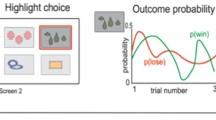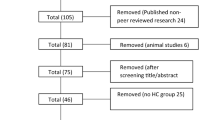Abstract
Although deep brain stimulation of the subthalamic nucleus is an effective surgical treatment for Parkinson’s disease, it may expose patients to non-motor side effects such as increased impulsivity and changes in decision-making behavior. Even if several studies have shown that stimulation of the subthalamic nucleus increases the incentive salience of food rewards in both humans and animals, temporal discounting for food rewards has never been investigated in patients who underwent STN-DBS. In this study, we measured inter-temporal choice after STN-DBS, using both primary and secondary rewards. In particular, PD patients who underwent STN-DBS (in ON medication/ON stimulation), PD patients without STN-DBS (in ON medication) and healthy matched controls (C) performed three temporal discounting tasks with food (primary reward), money and discount vouchers (secondary rewards). Participants performed also neuropsychological tests assessing memory and executive functions. Our results show that STN-DBS patients and PD without DBS behave as healthy controls. Even PD patients who after DBS experienced weight gain and/or eating alterations did not show an increased temporal discounting for food rewards. Interestingly, patients taking a higher dosage of dopaminergic medications, fewer years from DBS surgery and, unexpectedly, with better episodic memory were also those who discounted rewards more. In conclusion, this study shows that STN-DBS does not affect temporal discounting of primary and secondary rewards. Furthermore, by revealing interesting correlations between clinical measures and temporal discounting, it also shed light on the clinical outcomes that follow STN-DBS in patients with PD.



Similar content being viewed by others
References
Castrioto A, Lhommée E, Moro E, Krack P (2014) Mood and behavioural effects of subthalamic stimulation in Parkinson’s disease. Lancet Neurol 13:287–305. https://doi.org/10.1016/S1474-4422(13)70294-1
Okun MS, Fernandez HH, Wu SS et al (2009) Cognition and mood in Parkinson disease in STN versus GPi DBS: the COMPARE trial. Ann Neurol 65:586–595. https://doi.org/10.1002/ana.21596
Aiello M, Eleopra R, Lettieri C et al (2014) Emotion recognition in Parkinson’s disease after subthalamic deep brain stimulation: differential effects of microlesion and STN stimulation. Cortex 51:35–45. https://doi.org/10.1016/j.cortex.2013.11.003
Tröster AI, Jankovic J, Tagliati M et al (2017) Neuropsychological outcomes from constant current deep brain stimulation for Parkinson’s disease. Mov Disord 32:433–440. https://doi.org/10.1002/mds.26827
Jahanshahi M, Obeso I, Baunez C et al (2015) Parkinson’s disease, the subthalamic nucleus, inhibition, and impulsivity. Mov Disord 30:128–140. https://doi.org/10.1002/mds.26049
Kjær SW (2018) A systematic review of decision-making impairments in Parkinson’s Disease: dopaminergic medication and methodological variability. Basal Ganglia 14:31–40. https://doi.org/10.1016/j.baga.2018.07.003
Pham U, Solbakk A-K, Skogseid I-M et al (2015) Personality changes after deep brain stimulation in Parkinson’s disease. Parkinsons Dis. https://www.hindawi.com/journals/pd/2015/490507/abs/. Accessed 2015
Kirby KN, Herrnstein RJ (1995) Preference reversals due to myopic discounting of delayed reward. Psychol Sci 6:83–89. https://doi.org/10.1111/j.1467-9280.1995.tb00311.x
Evens R, Stankevich Y, Dshemuchadse M et al (2015) The impact of Parkinson’s disease and subthalamic deep brain stimulation on reward processing. Neuropsychologia 75:11–19. https://doi.org/10.1016/j.neuropsychologia.2015.05.005
Seymour B, Barbe M, Dayan P et al (2016) Deep brain stimulation of the subthalamic nucleus modulates sensitivity to decision outcome value in Parkinson’s disease. Sci Rep 6:32509. https://doi.org/10.1038/srep32509
Seinstra M, Wojtecki L, Storzer L et al (2016) No effect of subthalamic deep brain stimulation on intertemporal decision-making in Parkinson patients. eNeuro. https://doi.org/10.1523/ENEURO.0019-16.2016
Uslaner JM, Yang P, Robinson TE (2005) Subthalamic nucleus lesions enhance the psychomotor-activating, incentive motivational, and neurobiological effects of cocaine. J Neurosci 25:8407–8415. https://doi.org/10.1523/JNEUROSCI.1910-05.2005
Serranová T, Jech R, Dušek P et al (2011) Subthalamic nucleus stimulation affects incentive salience attribution in Parkinson’s disease. Mov Disord 26:2260–2266. https://doi.org/10.1002/mds.23880
Serranová T, Sieger T, Dušek P et al (2013) Sex, food and threat: startling changes after subthalamic stimulation in Parkinson’s disease. Brain Stimulation 6:740–745. https://doi.org/10.1016/j.brs.2013.03.009
Aiello M, Eleopra R, Foroni F et al (2017) Weight gain after STN-DBS: the role of reward sensitivity and impulsivity. Cortex 92:150–161. https://doi.org/10.1016/j.cortex.2017.04.005
Measso G, Cavarzeran F, Zappalà G et al (1993) The mini-mental state examination: normative study of an Italian random sample. Dev Neuropsychol 9:77–85. https://doi.org/10.1080/87565649109540545
Appollonio I, Leone M, Isella V et al (2005) The Frontal Assessment Battery (FAB): normative values in an Italian population sample. Neurol Sci 26:108–116. https://doi.org/10.1007/s10072-005-0443-4
Orsini A, Grossi D, Capitani E et al (1987) Verbal and spatial immediate memory span: normative data from 1355 adults and 1112 children. Ital J Neuro Sci 8:537–548. https://doi.org/10.1007/BF02333660
Novelli G, Papagno C, Capitani E et al (1986) Tre test clinici di ricerca e produzione lessicale. Taratura su sogetti normali. [Three clinical tests to research and rate the lexical performance of normal subjects.]. Arch Psicol Neurol Psichiatria 47:477–506
Carlesimo GA, Caltagirone C, Gainotti G et al (1996) The mental deterioration battery: normative data, diagnostic reliability and qualitative analyses of cognitive impairment. Eur Neurol 36:378–384
Sellitto M, Ciaramelli E, di Pellegrino G (2010) Myopic discounting of future rewards after medial orbitofrontal damage in humans. J Neurosci 30:16429–16436. https://doi.org/10.1523/JNEUROSCI.2516-10.2010
Smith CL, Hantula DA (2008) Methodological considerations in the study of delay discounting in intertemporal choice: a comparison of tasks and modes. Behav Res Methods 40:940–953. https://doi.org/10.3758/BRM.40.4.940
Baunez C, Dias C, Cador M, Amalric M (2005) The subthalamic nucleus exerts opposite control on cocaine and `natural’ rewards. Nat Neurosci 8:484–489. https://doi.org/10.1038/nn1429
Rouaud T, Lardeux S, Panayotis N et al (2010) Reducing the desire for cocaine with subthalamic nucleus deep brain stimulation. Proc Natl Acad Sci USA 107:1196–1200. https://doi.org/10.1073/pnas.0908189107
Aiello M, Eleopra R, Rumiati RI (2015) Body weight and food intake in Parkinson’s disease. A review of the association to non-motor symptoms. Appetite 84:204–211. https://doi.org/10.1016/j.appet.2014.10.011
Moeller FG, Barratt ES, Dougherty DM et al (2001) Psychiatric aspects of impulsivity. Am J Psychiatry 158:1783–1793. https://doi.org/10.1176/appi.ajp.158.11.1783
Witt K (2017) Chap. 25—The subthalamic nucleus in impulsivity. In: Dreher J-C, Tremblay L (eds) Decision neuroscience. Academic Press, San Diego, pp 315–325
Broos N, Schmaal L, Wiskerke J et al (2012) The relationship between impulsive choice and impulsive action: a cross-species translational study. PLOS One 7:e36781. https://doi.org/10.1371/journal.pone.0036781
Abbes M, Lhommée E, Thobois S et al (2018) Subthalamic stimulation and neuropsychiatric symptoms in Parkinson’s disease: results from a long-term follow-up cohort study. J Neurol Neurosurg Psychiatry 89:836–843. https://doi.org/10.1136/jnnp-2017-316373
Pine A, Shiner T, Seymour B, Dolan RJ (2010) Dopamine, time, and impulsivity in humans. J Neurosci 30:8888–8896. https://doi.org/10.1523/JNEUROSCI.6028-09.2010
Bobova L, Finn PR, Rickert ME, Lucas J (2009) Disinhibitory psychopathology and delay discounting in alcohol dependence: personality and cognitive correlates. Exp Clin Psychopharmacol 17:51–61. https://doi.org/10.1037/a0014503
Shamosh NA, DeYoung CG, Green AE et al (2008) Individual differences in delay discounting: relation to intelligence, working memory, and anterior prefrontal cortex. Psychol Sci 19:904–911
Heerey EA, Robinson BM, McMahon RR, Gold JM (2007) Delay discounting in schizophrenia. Cognitive Neuropsychiatry 12:213–221. https://doi.org/10.1080/13546800601005900
Hendrickson KL, Rasmussen EB (2017) Mindful eating reduces impulsive food choice in adolescents and adults. Health Psychol 36:226–235. https://doi.org/10.1037/hea0000440
Author information
Authors and Affiliations
Corresponding author
Ethics declarations
Conflicts of interest
On behalf of all authors, the corresponding author states that there is no conflict of interest.
Ethical standards
All participants gave written informed consent to participate in the study that was approved by SISSA Ethics Committee and has, therefore, been performed in accordance with the ethical standards of the Declaration of Helsinki.
Rights and permissions
About this article
Cite this article
Aiello, M., Terenzi, D., Furlanis, G. et al. Deep brain stimulation of the subthalamic nucleus and the temporal discounting of primary and secondary rewards. J Neurol 266, 1113–1119 (2019). https://doi.org/10.1007/s00415-019-09240-0
Received:
Revised:
Accepted:
Published:
Issue Date:
DOI: https://doi.org/10.1007/s00415-019-09240-0




